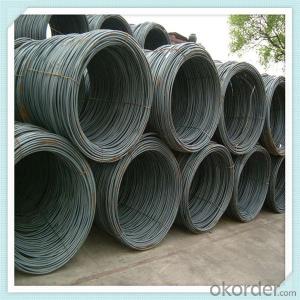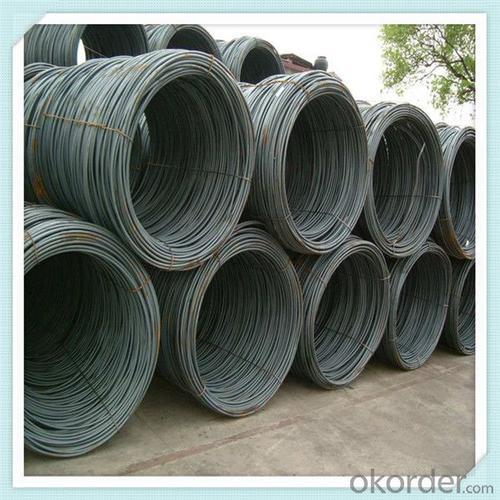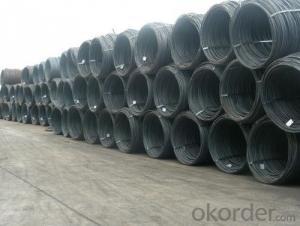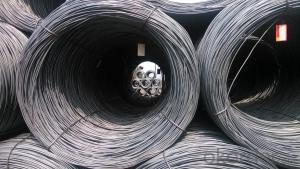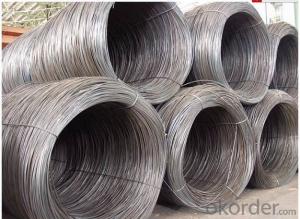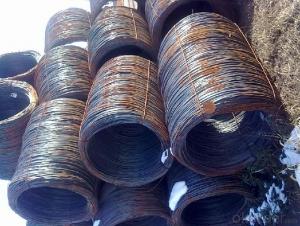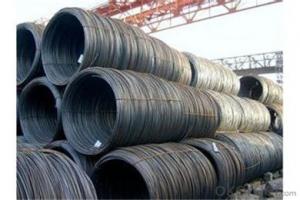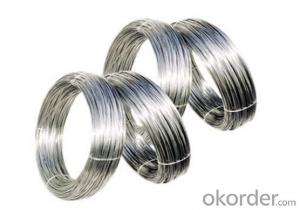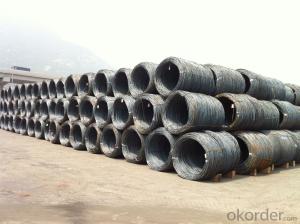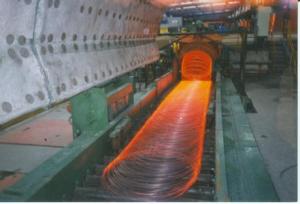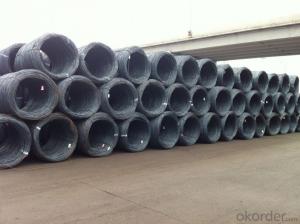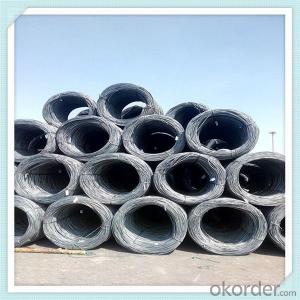SAE1008cr Steel wire rod cheap factroy price
- Loading Port:
- Tianjin
- Payment Terms:
- TT OR LC
- Min Order Qty:
- 100 m.t.
- Supply Capability:
- 19831 m.t./month
OKorder Service Pledge
OKorder Financial Service
You Might Also Like
Specification
Wire rod is used for many different products. Depending upon how it is cold formed and heat treated, wire
is used, for example, to produce not only wire ropes, barbed wire, wire mesh and nails, but also springs,
welded wire mesh and reinforcement wire.
Features
1、Pure steel quality, stable chemical contents, small tolerance.
2、Constant Quality, good drawing performance.
3、High dimension accuracy degree, accuracy degree of Level C up to 80%, smooth surface, less scale,
easy to be pickled.
4、Automatic bundling with 4 lines by Machine in tidy and good looks
5、Big high quality percentage, small coil percentage, and heavy coil weight for Hard Coil.
6、High sorbitizing percentage.
Product Description :
Standard | AISI, ASTM, BS, DIN, GB, JIS |
Material/steel grade | Q195-Q235,SAE1006B,SAE1006CR, SAE1008B, SAE1008CR, SAE1010B, SAE1018B, or according to customers requirements |
Wire Gauge | 5.5-12mm |
Coil weight | 1.8-2.1mts |
MOQ | 25MT |
Delivery Time | 15-30 days after receipt of L/C or deposit by T/T |
Packing | In coil and load in container, if large quantity, by bulk vessel; Can be packed as customers' special requirements |
Payment terms | 1).100% irrevocable L/C at sight. 2).30% T/T prepaid and the balance against the copy of B/L. 3).30% T/T prepaid and the balance against L/C |
Application | widely used in machinery parts, manufacturing industry, electronics industry, metal tools and others |
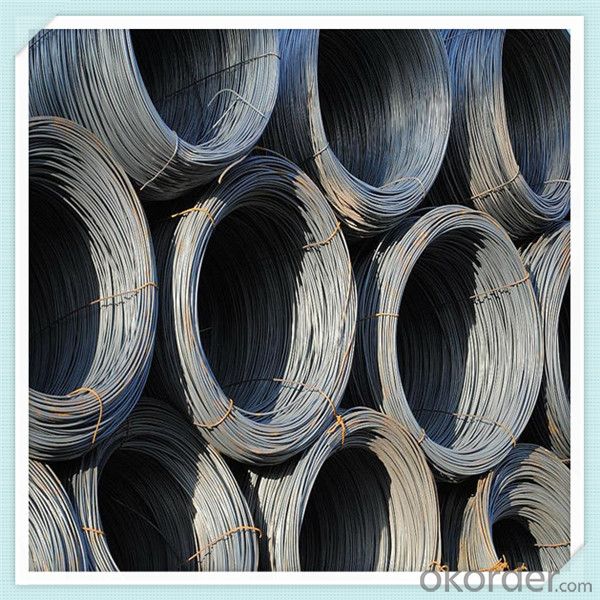
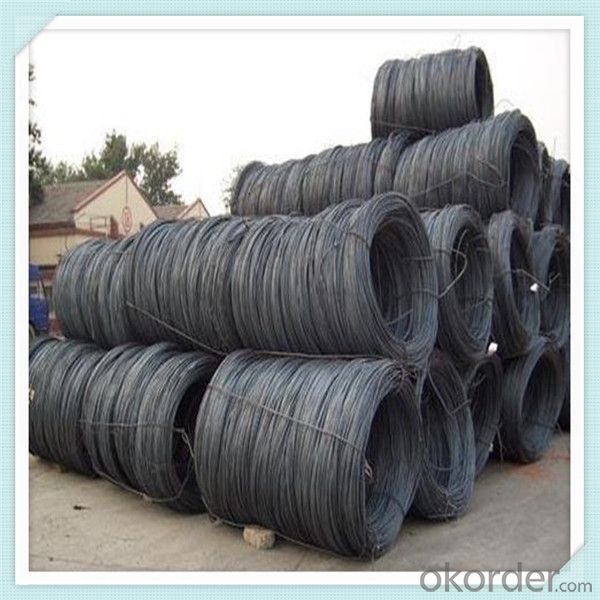
Application :
It generally used in braiding the hose for bathing product and machinery. With it
good flexibility, resistant to high temperature and resistant to corrosion, it
used widely in many industries.
Packing :
Hot-rolled wire rod is held in a unit with at least four steel straps in the
transverse direction and transported and stored without further packaging.
Before
the steel strapping is applied, the wire rod must be sufficiently compressed.
The strapping is fixed in the transverse direction with a single circumferential
strap so that the strapping does not slip and cause the coil to come apart.
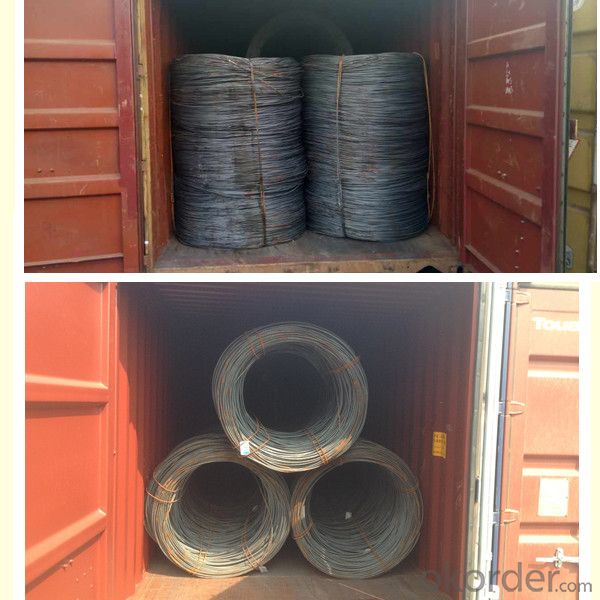
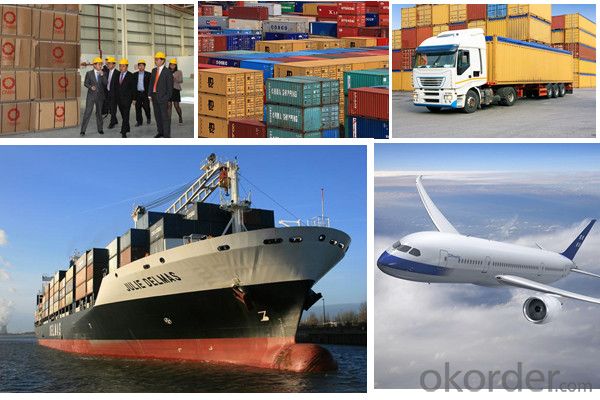
Our service:
(1) We cooperate with famous factories with advanced equipment and well trained workers.
(2) We can provide factory price with trading company service.
(3) We continuously work on the improvement of our processes, guaranteeing
consistently high standards of quality to keep none compensation.
(4) We guarantee 24 hours response and 48 hours solution providing service.
(5) We accept small order quantity before formal cooperation.
(6) We deliver the agreed quality at the agreed time, reacting to changes in
customer wishes in a flexible way.
(7) Due to our volume and selling power, we have excellent freight rates with
shipping lines.
(8) We strive to always be fair and honest in our dealings with customers.
(9) We strive to work together with customers to achieve much more than we can
achieve alone.
(10) Through our passion and commitment we aim to be a market leader in all our
key markets. To maintain our position as market leader we must continue to add
value in all that we do.
FAQ:
1.Q: What's your MOQ(minimum order quantity)?
A: One full container, mixed acceptable .
2. Q: What's your packing methods?
A: Packed in bundle or bulk ..
3. Q: How can I buy CNBM products in my country?
A:Please send us an inquiry or email ,we will reply to you if there is distributor in your country
4. Q: Can we visit your factory?
A: Warmly welcome. Once we have your schedule, we will arrange the
professional sales team to follow up your case.
5. Q: How long does it take to get the product if i place an order?
A:With the process of your requirements,we will pack and deliver in 3
-7 days. If it is by sea shipment,it will take 15-45 days depending on different locations
- Q: What are the main factors influencing the choice of steel wire rod order refund policy?
- When determining the refund policy for steel wire rod orders, the satisfaction of customers, cost implications, and market competition all come into play. To begin with, customer satisfaction is a key factor in shaping the refund policy. By offering a refund policy, the company can address any concerns or dissatisfaction that customers may have with the product quality or other aspects of their order. This customer-centric approach demonstrates a commitment to resolving issues and ensuring a positive experience, which in turn fosters trust and loyalty. Ultimately, this can lead to repeat business and positive word-of-mouth. Additionally, the financial implications of refunds are an important consideration. Companies must carefully evaluate the potential costs associated with refunding orders, particularly when dealing with larger or more frequent refunds. It is essential to strike a balance between customer satisfaction and financial feasibility. In some cases, implementing certain conditions or limitations on refunds may be necessary to mitigate the financial impact. Furthermore, market competition influences the choice of refund policy. In a highly competitive market, refund policies can serve as a distinguishing factor that attracts customers. By offering a more lenient refund policy compared to competitors, a company can gain a competitive edge and attract and retain customers. Conversely, if competitors have stricter refund policies, it may be necessary for a company to align its policy accordingly to prevent customer loss. Ultimately, the decision regarding the refund policy for steel wire rod orders is a strategic one that takes into account customer satisfaction, cost implications, and the competitive landscape. Striking the right balance between these factors is crucial for the company's success in the industry.
- Q: How does the carbon content affect the properties of steel wire rod?
- The carbon content in steel wire rod affects its properties by influencing its strength, hardness, and ductility. Higher carbon content generally leads to a stronger and harder wire rod with reduced ductility and increased brittleness. Conversely, lower carbon content results in a softer and more ductile wire rod with reduced strength. The carbon content also affects the wire rod's ability to be welded and its resistance to corrosion. Therefore, the carbon content plays a critical role in determining the overall performance and suitability of steel wire rod for various applications.
- Q: What are the different types of steel wire rod surface treatments?
- The different types of steel wire rod surface treatments include galvanizing, coating, passivating, and pickling.
- Q: What are the common industry standards for steel wire rod manufacturers?
- The common industry standards for steel wire rod manufacturers typically include specifications related to the chemical composition, mechanical properties, dimensional accuracy, surface quality, and packaging requirements of the wire rods. These standards are set by organizations such as the American Society for Testing and Materials (ASTM), International Organization for Standardization (ISO), and national or regional standards bodies. Compliance with these standards ensures the quality and consistency of steel wire rod products in the market.
- Q: What are the different surface treatments for steel wire rod?
- Steel wire rods can undergo different surface treatments to enhance their properties and improve performance in various applications. Common surface treatments include: 1. Pickling: Wire rods are immersed in an acid solution to remove oxide scale or rust, resulting in a clean surface, improved corrosion resistance, and preparation for further treatments. 2. Phosphating: Through a chemical conversion process, a thin layer of phosphate coating forms on the wire rod surface. This coating enhances adhesion of subsequent coatings, improves corrosion resistance, and provides a better surface for painting or other finishes. 3. Galvanizing: Wire rods are coated with zinc, which acts as a sacrificial anode and offers excellent corrosion resistance. Galvanized steel wire rods are ideal for outdoor applications or environments with high humidity or exposure to corrosive elements. 4. Electroplating: Metal is deposited onto wire rods using an electric current, allowing for various coatings like nickel, chrome, or copper. These coatings offer improved corrosion resistance, enhanced aesthetics, and increased hardness or wear resistance. 5. Heat treatment: Controlled heating and cooling processes alter the microstructure and mechanical properties of wire rods. This treatment can enhance strength, toughness, hardness, or ductility, depending on the specific heat treatment process applied. 6. Coating: Wire rods can be coated with protective or functional coatings like epoxy, polyethylene, or PVC. These coatings provide additional corrosion resistance, insulation, or lubrication properties and can be applied through processes like hot-dip coating, electrostatic powder coating, or extrusion coating. Each of these surface treatments for steel wire rods offers unique benefits and is chosen based on the specific application's desired properties and requirements.
- Q: How are surface defects in steel wire rod repaired or rectified?
- Surface defects in steel wire rod can be repaired or rectified through various methods. One common method is grinding or sanding, where the surface defect is removed by using abrasive materials or tools. This process eliminates any imperfections or irregularities on the surface, resulting in a smooth and even finish. Another method is called peeling, which involves removing a thin layer of the affected area using a peeling machine. This helps to eliminate any superficial defects, such as scale or oxidation, and improves the overall quality of the wire rod. In some cases, the defects may be too severe to be repaired through grinding or peeling alone. In such situations, the wire rod can undergo a process known as pickling or acid cleaning. This involves immersing the rod in an acidic solution, which removes any corrosion, scale, or other surface defects. After pickling, the wire rod is thoroughly rinsed and dried to prevent further damage. Electropolishing is another technique used to repair surface defects in steel wire rods. It involves immersing the rod in an electrolyte solution and applying an electric current. This process removes a controlled amount of material from the surface, effectively eliminating any defects and producing a smooth and polished finish. In addition to these mechanical and chemical methods, surface defects in steel wire rods can also be repaired through heat treatment processes. Annealing, for example, involves heating the wire rod to a specific temperature and then slowly cooling it down. This process helps to relieve internal stresses and improve the overall structure and surface quality of the rod. Overall, the repair or rectification of surface defects in steel wire rods requires a combination of techniques, depending on the severity and type of defect. By employing these methods, manufacturers can ensure that the wire rods meet the required quality standards and are suitable for their intended applications.
- Q: How is steel wire rod used in the manufacturing of wire forms for roller coasters?
- Steel wire rod is used in the manufacturing of wire forms for roller coasters by being shaped and bent into various structures and designs that provide structural support and safety for the roller coaster track. The wire rod is typically used to create loops, twists, turns, and other intricate elements that make up the track layout. Its high strength and durability make it an ideal material choice for withstanding the extreme forces and stresses experienced during roller coaster rides.
- Q: What are the advantages of using steel wire rod in agricultural applications?
- There are several advantages of using steel wire rod in agricultural applications. Firstly, steel wire rod is known for its strength and durability, making it suitable for heavy-duty tasks in the agricultural sector. It can withstand harsh weather conditions, heavy loads, and resist corrosion, ensuring a long lifespan. Secondly, steel wire rod is highly versatile, allowing it to be used in various applications such as fencing, trellising, and support structures. Its flexibility enables farmers to adapt it to their specific needs. Additionally, steel wire rod is cost-effective as it requires minimal maintenance and replacement, reducing long-term expenses. Lastly, steel wire rod is readily available and easily accessible, making it a convenient choice for agricultural operations.
- Q: What are the factors that affect the tensile strength of steel wire rod?
- The tensile strength of steel wire rod can be affected by various factors. These factors include: 1. The chemical composition of the steel, such as carbon, manganese, and silicon. The specific combination of elements can have a significant impact on the tensile strength. Higher carbon content generally increases strength, while other alloying elements can enhance or reduce strength based on their properties. 2. The heat treatment process, which involves heating and cooling the steel wire rod. This process can alter the microstructure of the steel and ultimately affect its tensile strength. Different methods, like quenching and tempering, can be used to achieve the desired strength level. 3. The manufacturing process of the steel wire rod. The way the rod is produced and processed can influence its tensile strength. Factors like rolling temperature, reduction ratio, and cooling rate can affect the alignment of the steel's crystalline structure, which in turn affects its strength properties. 4. The grain size of the steel wire rod. The size of the grains in the steel can impact its tensile strength. Smaller grain sizes generally result in higher strength, as they provide more barriers for dislocations to move through the material. 5. The surface condition of the steel wire rod. The presence of surface defects, such as cracks or scratches, can weaken the tensile strength. Therefore, proper surface treatment and handling during manufacturing and transportation are crucial for maintaining its strength. 6. The environmental conditions in which the steel wire rod is used. Factors like temperature, humidity, and exposure to corrosive substances can degrade or embrittle the material, leading to reduced strength. In conclusion, the tensile strength of steel wire rod is influenced by its chemical composition, heat treatment, manufacturing process, grain size, surface condition, and environmental factors. It is important to understand and control these factors to ensure the desired strength and performance of the steel wire rod in different applications.
- Q: What are the different types of steel wire rod surface defect detection and analysis tools?
- There are several types of steel wire rod surface defect detection and analysis tools available in the market. Some common tools include visual inspection, ultrasonic testing, magnetic particle testing, eddy current testing, and laser scanning. Each tool has its own advantages and limitations, and the choice of tool depends on factors such as the type of defect, the size of the wire rod, and the required accuracy of detection and analysis.
Send your message to us
SAE1008cr Steel wire rod cheap factroy price
- Loading Port:
- Tianjin
- Payment Terms:
- TT OR LC
- Min Order Qty:
- 100 m.t.
- Supply Capability:
- 19831 m.t./month
OKorder Service Pledge
OKorder Financial Service
Similar products
Hot products
Hot Searches
Related keywords
